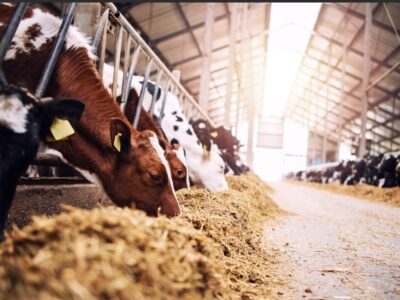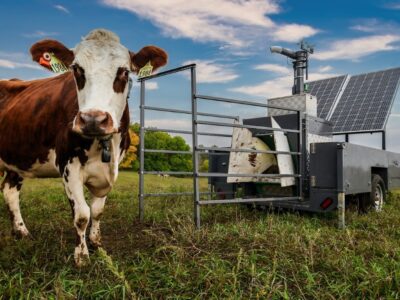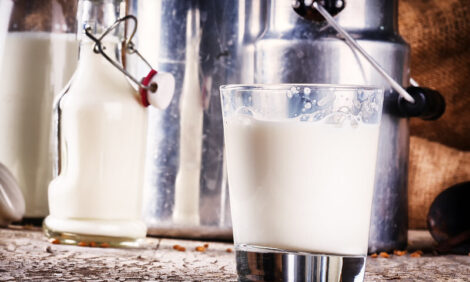



New research compares respiration chamber and GreenFeed to measure feed efficiency in dairy cows
Data shows GreenFeed offers accurate alternative to measuring individual dry matter intakeAccurately measuring how efficiently a dairy cow converts feed into milk has long been a challenge for both producers and researchers. While feed accounts for the single largest cost in milk production, on-farm measurement of individual dry matter intake (DMI) has been cumbersome, expensive, prone to error and difficult to manage commercial herds.
A new study by researchers at the Natural Resources Institute Finland (Luke) offers the dairy industry a promising alternative to accurately measure individual cow feed intake. Using the GreenFeed system, a commercially available tool from C-LOCK originally designed for methane measurement, the researchers demonstrated that feed efficiency can be reliably estimated from a cow’s gas exchange data. Their findings suggest that dairy producers can now rank cows for feed efficiency without the need for direct feed intake measurement, saving time, reducing labor and the potential to improve genetic selection accuracy.
Why measuring feed efficiency is difficult

In dairy cattle, feed efficiency (FE) is most often expressed as residual feed intake (RFI), which is the difference between a cow’s actual feed intake and the amount predicted from her milk production, metabolic body weight and body weight change. Cows with lower RFI values are more efficient because they eat less than expected for the same level of milk production while maintaining energy needs.
However, RFI depends on accurate daily feed intake data for individual cows, which is a major hurdle on commercial dairy operations. Variation in silage dry matter content, sampling errors and sorting behavior can lead to mistakes. Between-cow variation in RFI is small compared to day-to-day variation in DMI, making precision critical. Precise management of feeding bunks is often challenging and cost prohibitive at the commercial level.
Some proposed solutions include 3D cameras to measure the volume of feed consumed. But accuracy for ranking cows still needs validation. The Finnish research team instead explored whether energetics including oxygen (O₂) consumption, carbon dioxide (CO₂) production and heat production (HP) could serve as reliable FE indicators.
How gas exchange reflects efficiency
Gas exchange data can reveal how much energy an animal uses for maintenance and production. In respiration chamber (RC) studies, CO₂ production has been shown to accurately predict HP, which is closely tied to feed energy utilization.
The principle is straightforward:
- Efficient cows tend to consume less oxygen and produce less carbon dioxide per unit of milk, reflecting lower metabolic losses
- Inefficient cows have greater HP and CO₂ outputs relative to milk yield, often due to greater maintenance costs or less efficient energy conversion
The GreenFeed system, which is already used in more than 45 countries to measure methane emissions, also records CO₂ production and O₂ consumption when an oxygen sensor is included on the unit. These metabolic gases are measured during short voluntary visits where the cow receives a small amount of feed. This opens the possibility of using it as an indirect calorimetry tool for estimating FE.
"Measuring feed intake at the commercial level is often infeasible due to the sheer number of automated bunks required, which is further compounded by increased labor associated with bunk filling and cleaning. However, a single GreenFeed can accommodate up to 50 animals with minimal labor,” said Dr. Meredith Harrison, chief scientific officer at C-LOCK. “This makes GreenFeed a scalable solution for measuring feed efficiency on commercial farms."
Study design
The trial involved 32 Nordic Red dairy cows (26 primiparous, six multiparous) in mid-to-late lactation, averaging 159 days in milk, 634 kg (1,397 lbs.) body weight, and 28.9 kg (64 lbs.) milk per day. Cows were fed a grass silage-based diet (51:49 forage-to-concentrate ratio; crude protein 152 g/kg DM, NDF 395 g/kg DM).
The study included two 14-day measurement periods using the GreenFeed system in a free-stall barn. Over a one-week period between the GreenFeed periods, each cow spent three days in a respiration chamber for gas exchange measurement and total fecal and urine collection. Respiration chambers are designed to precisely measure gas exchange and are considered the gold standard for measuring emissions from ruminants. The chamber period was bracketed by the two GreenFeed periods to minimize diet and environmental effects.
On average, cows visited the GreenFeed system 3.6 times/day, receiving pelleted concentrate to encourage consistent head placement for accurate sampling. The GreenFeed and respiration chambers units were located in the same barn. The cows were fitted with transponder collars allowing for identification of the feeding bins, milking parlor and weigh scales, and all milk yield, milk composition and BW changes were recorded.
Calculating efficiency from gas data
The study focused on residual gas traits – values calculated as the difference between observed gas production and expected values based on energy requirements for maintenance and milk production:
- Residual CO₂ production (RCO₂): Observed CO₂ minus expected CO₂ based on maintenance and milk production requirements
- Residual O₂ consumption (RO₂): Observed O₂ minus expected O₂ based on maintenance and milk production requirements
- Residual HP (RHP): Difference between observed and expected HP
Residual methane (RCH₄) was also calculated, along with traditional intake-based measures:
- Residual ME intake (RMEI): Observed minus predicted metabolizable energy intake
- Feed Conversion Efficiency (FCE): Expressed as milk energy output per unit of metabolizable energy (ME) intake, CO₂ or O₂
Strong agreement between GreenFeed and respiration chambers
When comparing GreenFeed and respiration chamber data:
- Ranking consistency was high – 75% of cows ranked in the top 50% by GreenFeed were also in the top 50% by respiration chamber.
- Oxygen-based measures – Better agreement for RO₂ and RHP (R² = 0.68 and 0.67) than for RCO₂ (R² = 0.59), partly because O₂ measurements are less affected by eructation (belching) peaks and diet composition
In practical terms, this means that a farm using GreenFeed could identify its most efficient cows with confidence.
The study also tested whether GreenFeed gas data could predict DMI without weighing feed. Models using CO₂ or O₂ production plus energy corrected (ECM) milk yield predicted DMI more accurately than models using ECM yield and BW alone – both in GreenFeed and respiration chamber data.
This matters because if gas exchange can reliably predict DMI, then feed efficiency can be estimated without physically measuring feed offered and refused, which is a significant on-farm advantage.
Repeatability and reliability
Repeatability is critical for genetic selection. Traits with higher repeatability require fewer measurements to identify superior animals.
- Gas-based traits showed equal or higher repeatability than intake-based measures:
- Energy-corrected milk (ECM)/CO₂: 0.92
- ECM/O₂: 0.94
- Residual CO₂ production: 0.87
- Residual O₂ consumption: 0.92
- Residual HP: 0:91
- Intake-based ECM/DMI repeatability was lower at 0.74
This suggests that gas-based FE measurements are more stable over time than those derived from feed intake, which is influenced by daily variation and feed sampling errors, and these measures are stable enough for selection purposes.
Efficiency differences between cow groups
Cows were divided into low, medium, and high RCO₂ groups. Low-RCO₂ cows were more efficient than high-RCO₂ cows. The low-RCO₂ cows:
- Produced 13% less methane per kg ECM
- Had greater organic matter digestibility (697 vs. 680 g/kg)
- Produced less heat (123 vs. 137 MJ/day)
- Had greater FC efficiency whether expressed per unit ME intake or CO₂ production
While DMI and milk yield did not differ significantly between the groups, energy losses (heat, CO₂, methane) were lower in the efficient cow.
The study confirmed that genetically selecting for feed efficiency reduces methane intensity:
- High-RCO₂ cows produced 15% more methane per kg ECM than low-RCO₂ cows
- Differences in methane emissions were driven largely by high FE resulting differences in heat production differences digestibility
However, the reverse is not always true – selecting solely for lower methane output does not necessarily improve FE, because methane is just one minor part of total energy losses.
Why this matters to dairy producers

At the end of the day, feed efficiency isn’t just a scientific metric – it’s a business lever that helps producers make important decisions.
Costs: Improving how effectively a cow turns feed into milk directly cuts the amount of feed needed per pound or liter of milk, which in turn trims one of the biggest costs in milk production. That’s a win for any producer’s bottom line.
Environment: The environmental gains are equally compelling. The study showed that more efficient cows consistently emitted less methane per kilogram of ECM. In practical terms, that means the very cows that cost less to feed are also helping to meet the growing demands for lower carbon milk production. Efficiency and sustainability, which are often treated as separate goals, can move together.
Genetics: There’s also a genetic opportunity. Reliable FE data collected under real farm conditions can finally be included in breeding indexes, allowing efficiency to be selected alongside production, fertility and health traits. Over time, that genetic progress compounds, ultimately building herds that naturally produce more milk with fewer inputs.
Using GreenFeed on-farm to measure feed efficiency
Traditional intake-based measures of feed efficiency depend heavily on accurate feed sampling and chemical analysis – tasks that are both time-consuming and prone to error. Gas-based FE traits sidestep these requirements entirely.
Because they are based on energy losses measured through oxygen consumption and carbon dioxide production, they’re less sensitive to variations in diet metabolizable energy concentration. This stability makes them particularly valuable when comparing cows across different farms, where rations unavoidably differ.
Another advantage lies in consistency. GreenFeed units are calibrated centrally, meaning that a measurement taken on one farm can be confidently compared with data from another. Since the system is already designed to monitor methane, efficiency data can be gathered in parallel without additional labor or equipment which adds significant value to your investment.
If using GreenFeed to measure feed efficiency in grazing-based production systems, study author Dr. Pekka Huhtanen doesn’t see any problems.
“To get cows in GreenFeed units could be more challenging in pasture than in barn conditions. An advantage of GreenFeed system in estimating feed efficiency is that feed intake and analysis are not needed. Measuring feed intake in grazing conditions is laborious, expensive and has more uncertainties than intake measurements in barn conditions,” said Dr. Huhtanen. “It is surprising that the GreenFeed system has not been used more to measure feed intake in grazing conditions. The models based on O2 consumption/CO2 + energy corrected milk yield (ECM) production has predicted feed intake better than traditional models based on ECM yield and body weight.”
For producers or researchers with GreenFeed units with an oxygen sensor already in place, the next step is easy. If you don’t have an oxygen sensor, contact your C-Lock representative.
Gas exchange data should be collected routinely. According to the study, mid-lactation offers a particularly valuable window when cows are closer to energy balance. Ranking cows on residual O₂ or residual CO₂ indexes can highlight the animals that deliver the most milk for the least metabolic cost.
These rankings shouldn’t exist in isolation. The most powerful decisions will come from combining efficiency scores with production, fertility and health records, guiding both breeding and culling to steadily shift the herd toward greater profitability and resilience.
Breeding organizations can now begin integrating gas-based FE traits into genetic evaluations. Ensuring the results hold true across varying diets and production systems will be key to broad adoption, but the groundwork has already been laid by studies like this one.
Conclusions
The Finnish study demonstrates that GreenFeed systems can reliably estimate feed efficiency in dairy cows using gas exchange data, with results comparable to gold-standard respiration chambers. Additional GreenFeed system research projects are ongoing at the Natural Resources Institute Finland (Luke) to measure FE in practical on-farm conditions.
As the study authors conclude, “Our results suggest that cows can be ranked according to FE reliably based on gas exchanges determined by the GreenFeed system. Compared with intake-based FE traits, the values based on gas exchanges can have some benefits in on-farm conditions as the method is automated and does not require feed sampling and analysis.”
For producers and researchers, this represents a practical, on-farm tool to improve profitability, measure and reduce environmental footprint, and accelerate genetic progress toward more efficient herds without the challenges of individual feed intake measurement.
Reference
- Huhtanen, P. and Bayat , A.-R. (2025) ‘Potential of novel feed efficiency traits for dairy cows based on respiration gas exchanges measured by respiration chambers or GreenFeed’, Journal of Dairy Science. doi:10.3168/jds.2025-26683.



